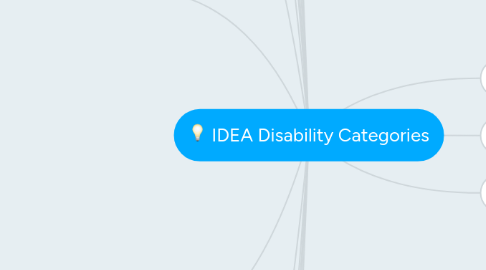
1. Specific Learning Disabilities
1.1. Characteristics
1.1.1. disorder in one or more of the basic psychological processes involved in understanding or in using language, spoken or written, that may manifest itself in the imperfect ability to listen, think, speak, read, write, spell, or to do mathematical calculations.
1.1.2. most often affected are: reading, writing, listening, speaking, reasoning, and doing math.
1.2. Interventions /Treatments
1.2.1. Special related services
1.2.2. https://www.youtube.com/watch?v=yG_xSBsFMPQ
2. Other Health Impairments
2.1. Characteristics
2.1.1. having limited strength, vitality, or alertness, including a heightened alertness to environmental stimuli, that results in limited alertness with respect to the educational environment
2.1.2. is due to chronic or acute health problems such as asthma, attention deficit disorder or attention deficit hyperactivity disorder, diabetes, epilepsy, a heart condition, hemophilia, lead poisoning, leukemia, nephritis, rheumatic fever, sickle cell anemia, and Tourette syndrome;
2.2. Interventions /Treatments
2.2.1. Will vary according to the condition
2.2.2. Special related services
3. Traumatic Brain Injury
3.1. Characteristics
3.1.1. injury to the brain caused by an external physical force, resulting in total or partial functional disability or psychosocial impairment,
3.1.2. injuries resulting in impairments in one or more areas,
3.1.2.1. language; memory; attention; reasoning; abstract thinking; judgment; problem-solving; sensory, perceptual, and motor abilities; psychosocial behavior; physical functions; information processing; and speech.
3.2. Interventions /Treatments
3.2.1. IEP
3.2.2. Medica/ according to injury
3.2.3. Vestibula,motor,therapies according to injury
3.2.4. Special related services
4. Visual Impairment /Blindness
4.1. Characteristics
4.1.1. impairment in vision that, even with correction, adversely affects a child’s educational performance.
4.2. Interventions /Treatments
4.2.1. Special Services
5. Speech or Language Impairment
5.1. Characteristics
5.1.1. communication disorder such as stuttering, impaired articulation, a language impairment, or a voice impairment that adversely affects a child’s educational performance.
5.2. Interventions /Treatments
5.2.1. Speech therapies
5.2.2. IEP
6. Orthopedic Impairment
6.1. Characteristics
6.1.1. affecting verbal and nonverbal communication
6.1.2. impairment that adversely affects a child’s educational performancecaused by a congenital anomaly, impairments caused by disease (e.g., poliomyelitis, bone tuberculosis), and impairments from other causes (e.g.,cerebral palsy, amputations, and fractures or burns that cause contractures).
6.1.3. resistance to environmental change or change in daily routines
6.1.4. Affects social interaction,
6.2. Interventions /Treatments
7. Multiple Disabilities
7.1. Characteristics
7.1.1. simultaneous or a combination of which causes such severe educational needs
7.2. Intervention/Treatments
7.2.1. Case Study 4 year old boy (Matteo)with multiple disabilities. Was born normally, had a stroke at 3 days of age paralyzing his right side of the body. No IEP. only class accommodations, OT Therapy, Psychological therapy, Special Ed teacher work on Reading Comprehension and writing strategies. Use assisstive technology such as computer or tablets for writing and recording as writing was extremely hard. At the end the year, full psychological evaluation was recommended as his progress was slow and has a shadow teacher for 3 times per week for half the day.
7.2.2. Varies depending on the dissabilities
7.2.3. Early Intervention
8. Intellectual Disabilities
8.1. Characteristics
8.1.1. sub average intellectual functioning
8.1.2. deficits in adaptive behavior
8.1.3. limitations in mental functioning and in skills
8.1.4. may take longer to learn to speak, walk, and take care of their personal needs such as dressing or eating
8.2. Interventions/Treatments
8.2.1. Rosas Law - cognitive disabilities or, previously, mental retardation
8.2.2. Behavior & Academic modification,IEP
8.2.3. Early Intervention
9. Hearing Impairment
9.1. Characteristics
9.1.1. impairment in hearing, whether permanent or fluctuating, that adversely affects a child’s educational performance
9.1.2. delayed in developing communication skills
9.1.3. does not respond consistently to sounds
9.2. Interventions/Treatments
9.2.1. Early intervention focuses on helping eligible babies and toddlers learn the basic and brand-new skills that typically develop during the first three years of life,
9.2.2. Speech and Language Therapy
9.2.3. Occupational Theraphy
9.2.4. Auditory processing theraphy
9.2.4.1. Case Study. 6 Year old boy, (Johnny) Mother had Chicken pox when pregnant. Diagnosed with with sever hearing loss at 2 years old. Attended regular school. Was on an IEP with differentiated instruction, Received Auditory Processing Therapy (NeuroNet), Speech and Language therapy, Had cochlea implant at age 8. Used assisstive technology such as hearing aid amplifiers in the classroom, audio recording to help him with his listening and speech. (FastForward & Lindamood-bell programs)
9.2.5. Medical services(implants)
9.2.6. Medical prosthesis; hearing aids, cochlear implants
10. Emotional Disturbances
10.1. Characteristics
10.1.1. An inability to learn that cannot be explained by intellectual, sensory, or health factors
10.1.2. An inability to build or maintain satisfactory interpersonal relationships
10.1.3. Inappropriate types of behavior or feelings under normal circumstances
10.1.4. A general pervasive mood of unhappiness or depression
10.1.5. A tendency to develop physical symptoms or fears associated with personal or school problems.
10.2. Intervention/Treatments
10.2.1. Behavior Interventions
10.2.2. Drug theraphy
10.2.3. Psychological intervention
11. Developmental Delay
11.1. Characteristics
11.1.1. Delay in one of the following areas physical development; cognitive development; communication; social or emotional development; or adaptive [behavioral] development.
11.2. Interventions
11.2.1. Speech therapies
11.2.2. Behavior Interventions
11.2.3. psychological interventions
11.2.4. Early intervention services
12. Deaf-Blindness
12.1. Characteristics
12.1.1. Simultaneous Loss of both hearing and sight
12.1.2. severe communication and other developmental and educational needs
12.2. Interventions
12.2.1. Special sensory media/technology
12.2.2. One on one teaching
13. Deafness
13.1. Charactristics
13.1.1. hearing impairment so severe that a child is impaired in processing linguistic information through hearing,
13.2. Interventions/Treatments
13.2.1. Sign Language /lip reading
13.2.2. Special use of technology/media
13.2.3. hearing processing therapies
13.2.4. Medical prosthesis; hearing aids, cochlear implants
14. Autism
14.1. affecting verbal and nonverbal communication
14.2. repetitive activities and stereotyped movemen
14.3. resistance to environmental change or changes in daily routines
14.4. Afects social interaction,
14.5. Interventions
14.5.1. Behavior Interventions
14.5.2. Dietary Modification
14.5.3. Various Theraphies
14.5.3.1. 3 year old girl (Muna) diagnosed with Autism, had a shadow teacher 3 times per week, Was on a behavior modification plan, Speech therapy, horse riding therapy, auditory processing therapy, Use Dolman-Delacatto method, Assisstive technology; use of computer and tablet for attention exercises and immediate positive reinforcement.
14.5.4. Early Intrvention
